If you may have tight calves, you understand lower-leg ache and motion restriction could make the entirety from doing a squat to descending a flight of stairs reputedly unattainable. You’ll have attempted stretching and foam rolling with restricted luck, or taken a therapeutic massage gun for your calves handiest to search out that, inside of an afternoon or so, you’re proper again to the place you began: strolling like Frankenstein.
Don’t concern: You’re now not destined to hobble round in discomfort endlessly, and also you don’t must accept squats that by no means wreck parallel. There’s a proper approach to stretch tight calves that results in longer-lasting reduction and progressed motion patterns.
For knowledgeable recommendation and steerage, we referred to as upon bodily therapists Grayson Wickham, PT, DPT, founding father of Motion Vault and Hilary Granat, PT, DPT, proprietor of C.O.R.E. Bodily Treatment. They shared their ideas on why your calves could also be seizing up and the most efficient calf stretch workout routines you’ll be able to do for that long-awaited reduction.
Which muscle tissues make up your calves?
The 2 number one muscle tissues that make up the calf are the gastrocnemius and the soleus. The gastrocnemius originates at two other issues of the femur (thigh bone) in the back of your knee. It travels down the again facet of your decrease leg the place, together with the soleus, it attaches to the Achilles tendon, which fits into the again of the heel. Originating on the best of the tibia (shin bone), the soleus runs underneath the gastrocnemius.
The gastrocnemius is the bulkier muscle of the 2 and provides your calf its unique form. In combination, the gastrocnemius and the soleus pressure plantar flexion, the ankle motion that issues your feet down and away out of your shin (take into consideration your foot urgent down on a gasoline pedal). By itself, the gastrocnemius additionally acts as a knee flexor.
What reasons tight calves, anyway?
Inaction can give a contribution to tight or motionless calves, consistent with Dr. Wickham.
“We sit down approach an excessive amount of and feature a loss of various motion,” he says, explaining that your frame will adapt to the rest you do (and don’t do). “In case your ankle seldom makes use of its complete vary of movement, your frame goes to conform to that and sooner or later get tight.”
And despite the fact that you do workout often, you should still lack mobility.
“Working handiest makes use of a restricted vary of movement. Doing a lunge handiest makes use of a restricted vary of movement,” he says. “Sadly, I see other people which were understanding for many years, they usually do various leg workout routines and calf raises, however they nonetheless have tight ankles.”
Dr. Wickham notes that not on time onset muscle soreness (DOMS) can really feel like tightness, nevertheless it’s brought about via the muscle harm that happens all through a brand new or tougher-than-usual exercise. In case your calves are continuously sore, you’ll be overtraining.
“Coaching an excessive amount of and now not getting better sufficient may end up in calf muscle tightness and cramping,” Dr. Granat says.
It’s additionally necessary to stick on best of your fluid consumption, she provides, as dehydration and electrolyte imbalance too can give a contribution to calf cramping.
The most efficient calf muscle stretches to alleviate tightness
Each and every of the next absolute best stretches, demonstrated via Dr. Wickham, employs one way referred to as lively (aka “dynamic”) stretching. So, somewhat than enjoyable right into a stretch or permitting gravity to do the paintings (aka “passive” or “static” stretching), you actively contract a muscle as soon as it’s absolutely stretched.
Energetic stretching workout routines now not handiest make stronger flexibility and mobility but in addition bolster joint energy and balance, muscle activation, and proprioception (frame consciousness), Dr. Wickham explains.
1. Energetic gastrocnemius stretch
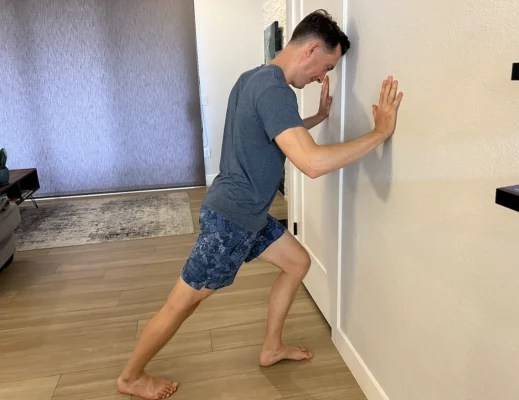
- Stand going through a wall together with your ft hip-width aside.
- Position your fingers at the wall for strengthen and step your proper foot in the back of you.
- Bend your left knee and straighten your proper leg, urgent your proper heel towards the bottom.
- As soon as you’re feeling a deep stretch to your decrease proper leg, contract your calf muscle via pushing the ball of your foot into the bottom, such as you’re pushing down on a gasoline pedal.
- Grasp the contraction for 10 to twenty seconds, then unlock it.
- Subsequent, contract the muscle tissues at the entrance of your ankle via pulling up to your foot, like you are taking your foot off the gasoline pedal.
- Grasp the contraction for 10 to twenty seconds, then unlock it.
- Repeat the series 3 to 4 instances, then transfer legs.
2. Energetic soleus stretch
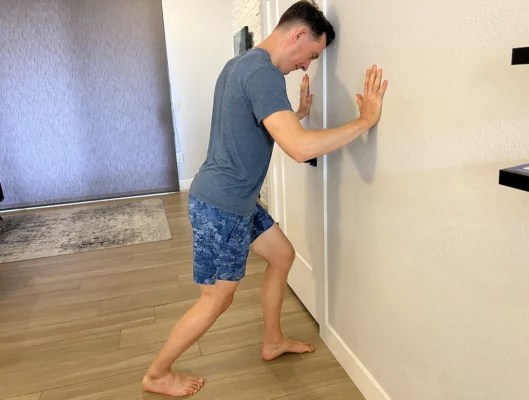
- Stand going through a wall together with your ft hip-width aside.
- Position your fingers at the wall for strengthen and step your proper foot in the back of you.
- Bend your left knee and push your proper heel towards the bottom, permitting a slight bend to your proper knee.
- As soon as you’re feeling a deep stretch to your decrease proper leg, contract your calf muscle via pushing the ball of your foot into the bottom, such as you’re pushing down on a gasoline pedal.
- Grasp the contraction for 10 to twenty seconds, then unlock it.
- Subsequent, contract the muscle tissues at the entrance of your ankle via pulling up at the foot, like you are taking your foot off the gasoline pedal.
- Grasp the contraction for 10 to twenty seconds, then unlock it.
- Repeat the series 3 to 4 instances, then transfer legs.
3. Part-kneeling calf stretch
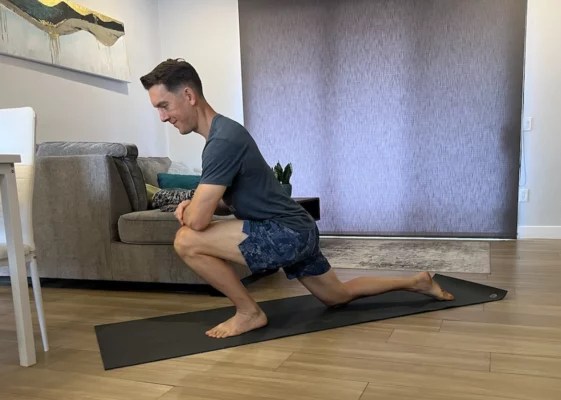
- Start in a half-kneeling place together with your left knee bent at 90 levels and your left foot flat at the flooring.
- Position your proper knee at the flooring on best of a mat or cushion.
- Retaining your left heel at the flooring, pressure your left knee ahead over your feet till you’re feeling a stretch to your left calf and the again of your left ankle.
- Contract your left calf muscle via pushing the ball of your foot into the bottom, such as you’re pushing down on a gasoline pedal.
- Grasp the contraction for 10 to twenty seconds, then unlock it.
- Subsequent, contract the muscle tissues at the entrance of your ankle via pulling up at the foot, like you are taking your foot off the gasoline pedal.
- Grasp the contraction for 10 to twenty seconds, then unlock it.
- Repeat the series 3 to 4 instances, then transfer legs.
4. Detrimental calf carry
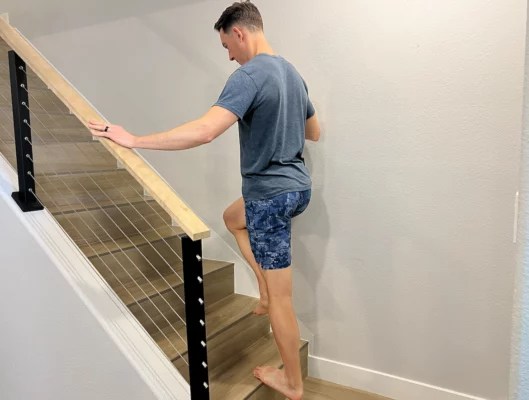
- Stand at the fringe of a step or field in order that each heels are striking over the threshold.
- Protecting onto a railing or solid construction for strengthen, raise your proper leg in order that you’re balancing to your left foot. (To make this motion more straightforward, stay each ft at the step.)
- Carry out a calf carry to your left leg via pushing during the ball of your left foot and lifting your heel as top as conceivable.
- Subsequent, rely to ten as you slowly decrease your heel so far as you’ll be able to. You will have to really feel a deep stretch within the running calf.
- Repeat till your calf muscle fatigues (typically 5 to twenty reps), then transfer legs.
5. Managed ankle circle
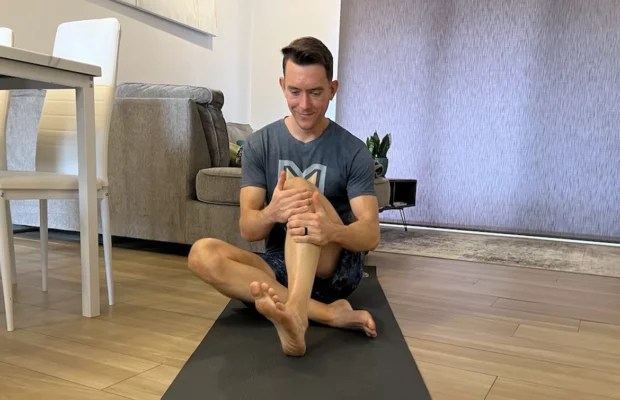
- From a seated, cross-legged place, prolong your left leg in entrance of you. Bend your left knee and position each fingers to your shin. (This helps to keep your knee from transferring back and forth.)
- Slowly rotate your ankle in a clockwise path. Interact your calf muscle tissues as you center of attention on transferring via your ankle’s complete vary of movement.
- Carry out 5 to ten ankle circles, then opposite path to do 5 to ten circles counter-clockwise.
- Transfer legs and repeat.
FAQ
1. How lengthy will have to you stretch tight calves?
Dr. Wickham recommends spending no less than 10 mins on lively stretching 3 times per week. Those periods will have to come with the calves in addition to the entire different spaces of the frame.
“Any tight muscle tissues or volatile joints are susceptible hyperlinks to your kinetic chain that would result in joint repayment that results in ache and damage down the road,” he says.
Any individual with very tight calves might wish to building up their overall period of time stretching so they are able to spend extra time that specialize in the calves and ankles.
2. Can therapeutic massage loosen tight calves?
A conventional therapeutic massage will really feel just right, nevertheless it received’t have an enduring impact on tight calves. Then again, self-myofascial unlock (SMR), aka “foam rolling,” can ship messages to the fearful machine to lower muscle tone, inflicting tightness.
Dr. Wickham recommends making use of force to any delicate spots whilst slowly flexing and pointing your foot somewhat than simply rolling up and down your calf.
3. My calves nonetheless really feel tight after stretching. What will have to I do?
Calf ache, cramping, and tightness that doesn’t pass away may point out different well being issues, like deficient stream or nerve compression, consistent with Dr. Granat.
“Sciatica or a pinched nerve within the again could cause calf muscle tightness and cramps,” she says.
Different doable reasons come with postural problems, like leaning too a long way ahead and hyperextending your knees, and biomechanical issues to your ft.
“Overpronation of the foot, when the foot rolls in an excessive amount of or flattens, can put a repetitive pressure to your calf, which is able to result in tightness. Additionally, if the foot isn’t robust sufficient, it may end up in calf issues,” she says.
So, if lively stretching isn’t serving to your tight calves, make an appointment together with your physician or bodily therapist.